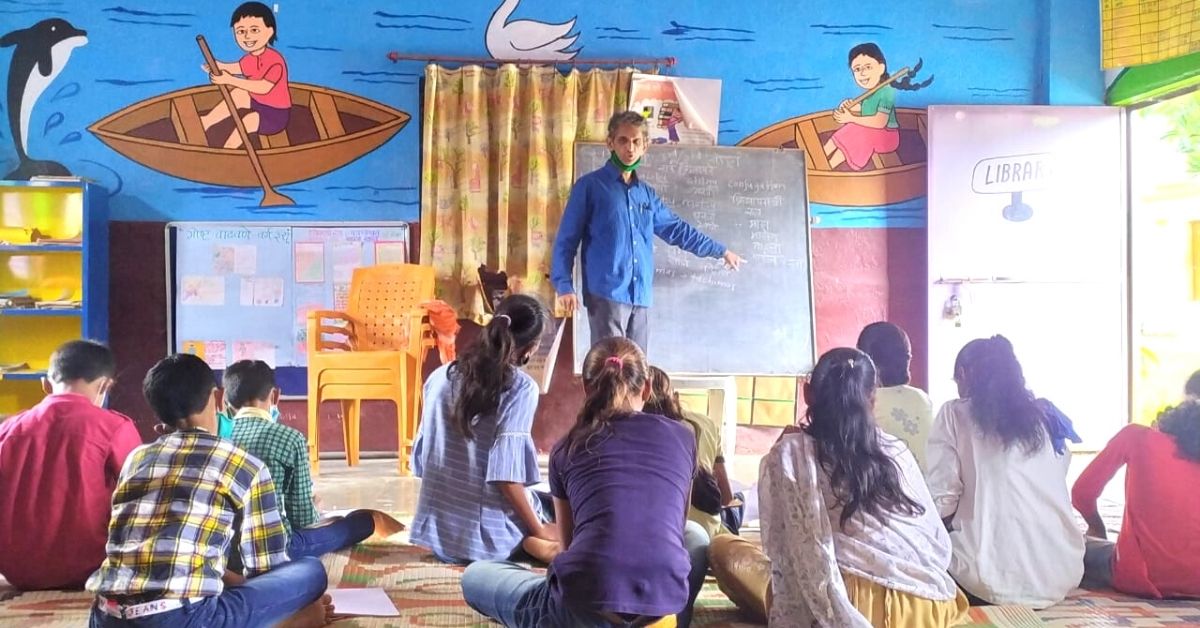Why One Man is Teaching Japanese to 100 Kids in Rural Maharashtra, Even on Weekends
Inspired by success in a National Robotic Competition, 100 students from ZP school, Gadiwat near Aurangabad are learning Japanese for a future trip to Japan

“Mizu O Kudasai. Gadiwat Kara Aurangabad Made Basu de Nan Jikan Gurai Kakarimas Ka? Watashi no Namaewa Nan Desu ka?” The above lines might be hard to fathom for some of our readers, but if you have learnt Japanese at some point in your life, you should get the gist of it.
“The first sentence I spoke means, ‘please give me water’ and the second one translates to – ‘approximately how many hours does it take the bus to travel from Gadiwat to Aurangabad?’ The third question means ‘what is my name’?,” says Vaishnavi Kolge, a class VIII student at the Zilla Parishad primary school located in Gadiwat village near Aurangabad.
Conversing in beginner-level Japanese has become a part of daily life for the 100-odd students at the Zilla Parishad, even though the village has little internet connectivity.
This village, in the middle of Maharashtra, has only one school. There are no private schools or even proper infrastructure, despite being only 20 km away from Aurangabad, a major industrial hub. So why Japanese? It all began with robots.
Robots to Japanese Lessons
“Until a few months ago, we did not know what a robot was and the feats they can achieve. But we went to Mumbai to compete in a robotic competition that changed everything,” says Vaishnavi.
In December 2019, about 15 students from Class V to VIII were selected for a robotic competition held in Mumbai. “One of our teachers introduced us to robots and coding, informed us about the competition and helped us participate in it,” she adds.
The teacher said that in November first week, one of the parents shared a link about the competition with him. “We decided to register for the competition and participate. Two experts from the organising team were invited to teach the students about the basics of coding,” he added.
Dadasaheb said the fees of Rs 40,000 was collectively paid to the experts by the parents. “The two-day training got conducted on November 22 and 23 at the school for the competition scheduled to get held in December,” he added.
The teacher said that two Class VIII students Vaibhav and Sainath Kolge were quick learners and immediately grasped the logic behind coding. “Since then the website kept updating about the code and line of programming which the students had to alter. The students spent about 13 hours a day updating these codes every three days,” Dadasaheb told The Better India.
Dadasaheb further said the competition eventually got held in January at Andheri where the students participated.
Explaining the course of the competition, Dadasaheb said the students had to compete at two stages. “One part included Double Power Direct Through (DPDT) technique where the robot is operated with the help of remote control to complete a track of obstacles. The other part involved entering code to the robot to perform a run through the obstacle course. The group ranked third as the robot touched too many obstacles increasing the error,” he explained.
Not without learning Japanese
“We came back and realised there is so much in the field of robotics and discussed how we could progress from the learnings at the competition,” Vaishnavi told The Better India.
Seeing their interest, the teachers of the school shared with students that Japan was the place where robotics was the most advanced, but one had to learn the language to really get into it.
“We were given a choice to learn German or Japanese, but given our interest in learning robotics, we decided to learn Japanese,” Vaishnavi added.
“Students asked if they could travel or work in the robotics industry to develop into a career and what needed to get done. So it was suggested that language was the first barrier,”
Dadasaheb said that ever since the lockdown began in March, students began watching YouTube videos, some guided video tutorials, Google translate options and other online studying material to grasp the fundamentals.
“The method did not yield results. The Google translate did not always give correct answers, and even the Apps couldn’t help much beyond the learning of single words,” Dadasaheb said. The future looked dim for the students until a Japanese language expert came to know about the efforts put in by students.
“I came to know about the students’ efforts through a journalist and volunteered to help. The pronunciation needed refining, and many aspects are being addressed,” Sunil Jogdeo from Aurangabad, said.
Sunil, a consultant in Human Resource Development, said that he last taught the language to engineering students in 2000. “That was the last time I did it professionally, so I decided to get my hands in it again for the students,” he added.
The Japanese language teacher said technical hindrances slowed the learning process. “The village has a lot of connectivity issues, and an hour-long session gives students about 15 minutes of lessons. For the last three weeks, I have been visiting every Thursday and teaching the students for the entire day,” Sunil said.
Sunil said that a plan gets presented every week which the students have to follow. “Physical learning is helping them learn at a faster pace. We aim for students to participate in the Japanese Language Proficiency Test (JLPT) in July later this year,” the teacher said adding the aim is to move systematically towards the cause.
Vaishnavi says learning a new language has helped her improve her English as well. “Our teacher Dadasaheb said that we need to have good command over English to be able to translate and understand the study material on Japanese better. So it helped both ways,” she said.
The teenager added that initially, the students found the language very difficult. “We eventually realised that the Japanese language is not so difficult. I find speaking Japanese easier than my mother tongue Marathi,” Vaishnavi said.
(Edited by Vinayak Hegde)
This story made me
- 97
- 121
- 89
- 167
Tell Us More
We bring stories straight from the heart of India, to inspire millions and create a wave of impact. Our positive movement is growing bigger everyday, and we would love for you to join it.
Please contribute whatever you can, every little penny helps our team in bringing you more stories that support dreams and spread hope.



















